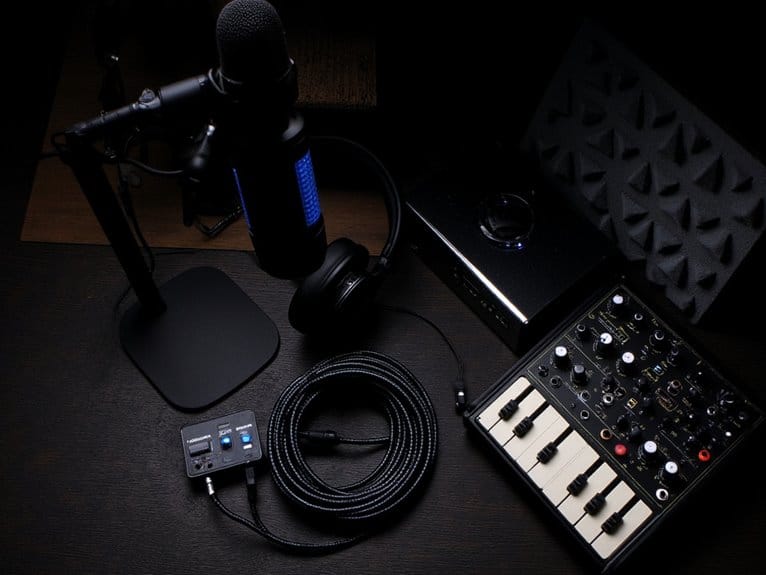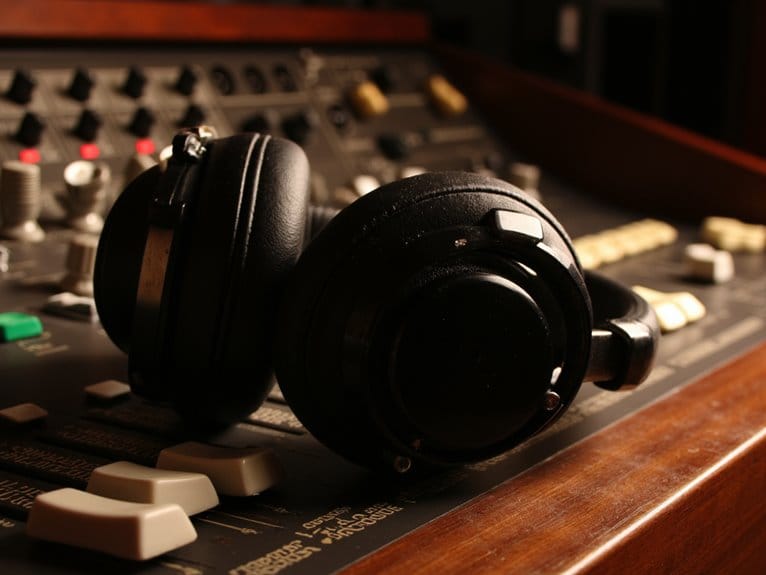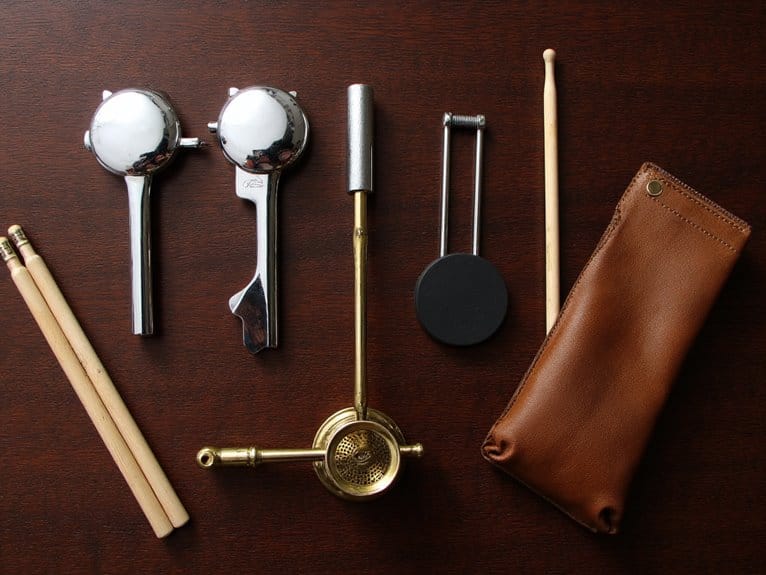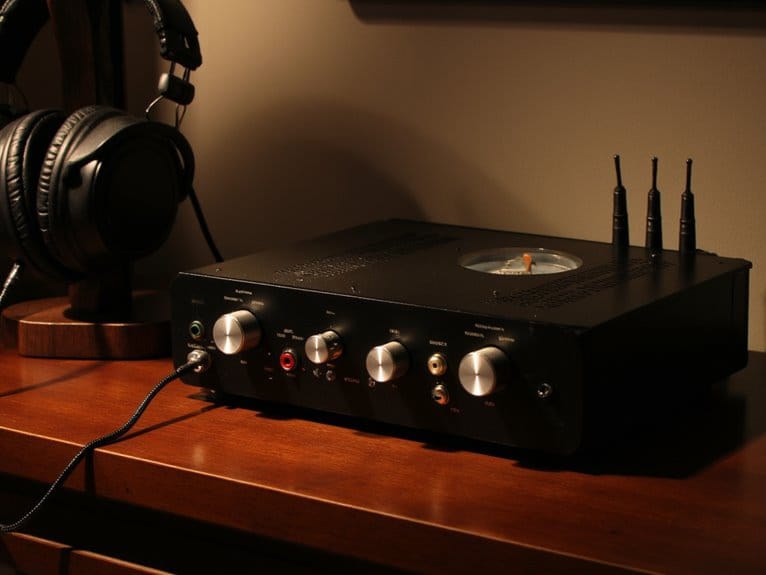Understanding Guitar Wiring: Series Vs Parallel Configurations
When you wire pickups in series, you’re connecting them end-to-end, which doubles resistance from 8kΩ to 16kΩ and creates a thick, warm humbucker-like tone with enhanced midrange punch. Parallel wiring connects outputs separately, halving resistance to 4kΩ while preserving bright, articulate single-coil clarity with higher treble response. Series configuration drives your amp harder for natural tube saturation, while parallel maintains clean articulation—and these switching options release even more tonal versatility.
We are supported by our audience. When you purchase through links on our site, we may earn an affiliate commission, at no extra cost for you. Learn more.
Notable Insights
- Series wiring connects pickups end-to-end, doubling resistance and producing thicker, warmer tones with enhanced midrange punch.
- Parallel wiring connects pickups separately, halving resistance and delivering brighter, clearer tones that preserve individual pickup characteristics.
- Series configuration generates higher output voltage for increased amplifier drive and richer harmonic distortion during overdrive.
- Parallel wiring maintains higher resonant frequencies (9-10 kHz) compared to series wiring’s lower frequencies (below 9 kHz).
- Modern switching options like push-pull pots and mini toggles allow guitarists to alternate between configurations without permanent modifications.
Basic Principles of Series and Parallel Pickup Wiring
When I first started modifying guitar wiring decades ago, I’ll admit the difference between series and parallel pickup configurations seemed like electrical wizardry.
What once felt like mystical electronics now makes perfect sense with hands-on experience and proper understanding.
However, understanding these fundamental concepts will transform how you think about your instrument’s tone.
Series wiring connects your pickups end-to-end, creating a signal chain where electricity flows sequentially through each pickup, effectively combining their outputs into one larger, more powerful unit.
Parallel wiring, conversely, connects pickup outputs separately to your output jack, allowing signals to travel independently before combining at the output.
While working with different pickup types requires attention to wiring safety protocols, these configurations dramatically alter your guitar’s electrical characteristics.
Series produces higher output voltage and fuller tone, while parallel maintains clarity and individual pickup character. The shorter wiring in parallel configurations leads to less resistance and often results in clearer, more defined tones. Interestingly, approximately 90% of guitarists remain unaware of these fundamental wiring differences despite their significant impact on tone.
Electrical Characteristics and Resistance Measurements
Now that you understand how series and parallel wiring affect your guitar’s signal flow, the electrical characteristics behind these configurations reveal why they sound so different, and it all comes down to resistance measurements that you can actually verify with a simple multimeter.
When you wire two 8kΩ pickups in series, you’ll measure approximately 16kΩ total resistance, while parallel wiring yields roughly 4kΩ—a dramatic resistance variation that directly impacts your tone.
These measurement techniques require accounting for your guitar’s complete circuit, including potentiometers, switches, and wiring components that influence final readings. Different pickup types require specific potentiometer values, with 250k pots traditionally used for single coils and 500k pots for humbuckers to achieve proper impedance matching.
Series wiring’s higher resistance creates natural treble attenuation, producing warmer, beefier tones, whereas parallel configuration’s lower resistance preserves clarity and brightness by maintaining high-frequency response through reduced signal path resistance. Just as oxygen-free copper conductors in quality instrument cables ensure clean signal transmission, the internal wiring of your guitar must maintain signal integrity from pickup to output jack. Professional audio setups benefit from power conditioning to eliminate electrical noise that can interfere with guitar signal clarity and overall recording quality.
Many Flying V guitars feature high-output ceramic humbuckers that particularly benefit from understanding these wiring configurations, as their robust signal characteristics can be tailored through different series and parallel combinations.
Output Voltage and Signal Strength Differences
While resistance measurements tell part of the story, the voltage output differences between series and parallel wiring configurations reveal why these setups produce such distinctly different signal strengths and tonal characteristics that you’ll immediately notice when you plug into your amp.
Series wiring fundamentally sums your pickups’ voltages, creating roughly double the output compared to a single pickup, while parallel configurations maintain approximately the same voltage as one pickup operating independently.
Series wiring doubles pickup voltage output while parallel wiring maintains single pickup voltage levels.
This voltage difference directly affects your signal’s perceived loudness, though your ears don’t interpret doubled voltage as doubled volume due to non-linear hearing perception.
The pickup alignment you choose also influences output impedance—series doubles it, parallel cuts it in half—which explains why parallel setups deliver brighter, clearer signals while series produces thicker, louder tones with enhanced mid-range emphasis.
Tonal Properties and Sound Characteristics
When you’re choosing between series and parallel wiring configurations, you’ll discover that each approach creates distinctly different tonal characteristics that can dramatically transform your guitar’s voice.
Series wiring delivers that classic, thick humbucker sound with enhanced midrange punch and warmth, while parallel wiring offers a brighter, more transparent tone that closely resembles single-coil clarity with the bonus of hum cancellation.
The frequency response differences between these two wiring methods are so pronounced that many players consider them essential tools for shaping their sonic palette, particularly when you factor in how each configuration responds to your playing dynamics and pickup attack.
Series Wiring Characteristics
Since series wiring fundamentally alters how your guitar’s pickups interact electrically, the tonal characteristics you’ll experience represent a marked departure from standard parallel configurations. When you engage pickup combinations in series mode, you’re fundamentally creating a longer signal path that emphasizes low and midrange frequencies while attenuating treble response. This results in what many players describe as a “beefier” or warmer tone profile, though you’ll notice some compromise in signal integrity regarding high-frequency clarity.
| Frequency Range | Series Wiring Effect |
|---|---|
| Low Frequencies | Enhanced/Boosted |
| Midrange | Emphasized prominence |
| High Frequencies | Attenuated/Reduced |
| Overall Volume | appreciably increased |
| Tonal Character | Warm, thick, beefy |
The increased resistance in series configurations acts like a natural filter, dampening treble while promoting midrange articulation that drives tube amplifiers into natural saturation more effectively. When recording these enhanced midrange frequencies, consider using microphones with appropriate frequency response characteristics to capture the full tonal complexity of your series-wired pickup configuration.
Parallel Wiring Benefits
The transparency that parallel wiring delivers represents a complete reversal of the series approach, prioritizing clarity and brightness over the warm thickness we just explored.
When you wire your humbuckers in parallel, you’re fundamentally creating a tonal orchestration that emphasizes treble frequencies and articulation, producing that distinctive “quacky” character that’s perfect for clean settings.
I’ve found that parallel wiring reduces your output by roughly half compared to series configuration, which actually works in your favor by preventing amp saturation and maintaining crystal-clear definition.
The beauty of this setup lies in its ability to preserve hum-canceling properties while delivering Strat-like sparkle, making it invaluable for funk, jazz, and pop applications where note separation matters most.
Just as acoustic guitars benefit from solid spruce tops that deliver crisp, bright tones with excellent clarity, parallel wiring achieves similar tonal transparency in electric instruments.
Similar to how drummers benefit from adjustable features in their equipment to customize their sound across different musical styles, parallel wiring gives guitarists the flexibility to adapt their tone for various genres from jazz to metal.
This tonal clarity becomes especially valuable when using lighter gauges, which naturally produce brighter tones that complement the parallel configuration’s emphasis on treble frequencies and articulation.
Frequency Response Differences
While parallel wiring delivers that crystalline clarity we’ve covered, series wiring fundamentally reshapes your pickup’s frequency response through increased inductance and resistance, creating a dramatic shift toward lower frequencies that defines its characteristic warmth. The combined coils lower your resonant frequency below the typical 9-10 kHz range, emphasizing midrange punch and bass presence while rolling off treble content. This creates those coveted vintage-style tones that sound fuller but less articulate than parallel configurations.
| Wiring Type | Resonant Frequency | Tonal Character |
|---|---|---|
| Series | Lower (sub-9kHz) | Warm, full, punchy |
| Parallel | Higher (9-10kHz) | Bright, clear, articulate |
Understanding these frequency response differences helps you choose configurations that match your tonal variations preferences, whether you’re chasing crystalline highs or warm, saturated mids. For guitarists seeking to enhance these tonal characteristics further, overdrive distortion pedals can amplify the natural warmth of series wiring or add clarity to parallel configurations across various musical genres. Metal musicians particularly benefit from series wiring’s enhanced mid-boost functions when paired with high-gain distortion pedals for maximum tonal impact.
Standard Applications and Guitar Modifications
Understanding how pickup wiring configurations actually work in practice helps demystify the tonal differences you’ll hear when switching between positions on your guitar. I’ve found that most players don’t realize how dramatically these wiring choices affect their sound.
Series wiring connects your pickups end-to-end, boosting output while creating that thick, warm tone you’d want for rock and heavier styles, whereas parallel wiring keeps things clearer and brighter, like you’d hear in traditional Stratocasters.
Series wiring delivers thick, warm tones perfect for rock, while parallel wiring maintains the clear, bright sound of classic Stratocasters.
Modern pickup configurations offer incredible wiring versatility through modifications like series/parallel switches, coil splitting, and custom pot values—250k for single coils, 500k for humbuckers. Recording your guitar’s different wiring configurations becomes essential when working with budget audio interfaces that can capture these tonal nuances professionally.
You can add push-pull pots or mini switches to toggle between wiring modes without permanent changes, giving you studio-quality tonal options. The wiring configuration differences between 2-conductor and 3-conductor pickups can complicate installation but provide more flexibility for these advanced switching options. Four-conductor wiring enables even more switching possibilities like coil-splitting and phase reversal modifications.
Humbucker-Specific Wiring Techniques
When you’re working with humbuckers, you’ll discover that these dual-coil pickups offer considerable more wiring flexibility than their single-coil counterparts, though the increased complexity requires careful attention to coil phasing and lead identification.
Standard humbucker wiring connects both coils in series configuration, where the north coil’s start becomes your hot output while the finish leads from both coils create the series link that delivers maximum output and complete hum cancellation.
However, you can dramatically expand your tonal palette by incorporating series/parallel switching methods, which allow you to toggle between the traditional fat, warm humbucker sound and a brighter, more single-coil-like tone that maintains noise rejection but reduces overall output.
Standard Humbucker Wiring
Since I’ve spent countless hours troubleshooting humbucker installations gone wrong, I can tell you that understanding the fundamental wiring structure of these dual-coil pickups is absolutely essential before you attempt any modifications or replacements.
The humbucker fundamentals center on series wiring, where the red and white leads connect internally to join two coils together, creating the characteristic thick tone and hum-canceling properties you’re after.
When you grasp these wiring challenges, you’ll realize that output flows from one coil’s start lead to the other’s finish lead, combining both signals effectively.
This series configuration delivers higher output than single coils while maintaining proper phase relationships between the north and south magnetic polarities of each coil. Many metal players specifically seek this high-output capability, as pickups ranging from 15k to 20k ohms provide the maximum output necessary for producing aggressive sound in extreme metal genres.
While humbuckers excel at providing powerful, noise-free tones, many players also appreciate the split-coil pickup configuration found in Precision basses, which offers its own distinctive tonal character through a different approach to dual-coil design. When transporting guitars with these valuable pickups, a proper hard-shell case provides superior protection compared to soft cases, ensuring your investment remains safe during travel.
Series/Parallel Switching Methods
While standard series wiring delivers that thick, powerful humbucker tone we’ve all come to expect, I’ve found that adding series/parallel switching capabilities transforms a single pickup into what’s fundamentally two distinct voices within the same housing.
You’ve got two primary switching methods to implement this modification. Push/pull pots remain the most popular choice since they maintain your guitar’s original appearance while adding functionality, though I’ll admit the pulling action takes some getting used to. Toggle switches provide more tactile feedback and quicker switching between modes, making them ideal for performance situations where you need immediate tonal changes.
| Switching Method | Implementation Difficulty |
|---|---|
| Push/Pull Pot | Moderate |
| Mini Toggle | Easy |
| 5-Way with Series/Parallel | Advanced |
| Freeway Switch | Moderate |
| Custom Harness | Advanced |
Effects on Guitar Controls and Signal Processing
The choice between series and parallel pickup wiring creates a ripple effect that extends far beyond the pickups themselves, fundamentally altering how your guitar’s controls respond and how the signal interacts with your amplifier.
Pickup wiring decisions cascade through your entire signal chain, reshaping everything from control response to amplifier interaction.
When you’re dealing with parallel wiring, your pickups feed the volume control interaction more independently, which means tone controls behave differently depending on your pickup selector position.
Series wiring, however, combines signals into one cohesive unit, producing smoother tone adjustment effects across all positions. Many guitarists find that dual humbucker pickups in series configuration provide excellent sound quality across various music genres from jazz to rock.
The higher resistance from series wiring drives your amp’s input stage harder, creating richer harmonic distortion and tube saturation, while parallel wiring delivers cleaner, more articulate signals that preserve transient attack and note definition. Understanding these resistance levels becomes crucial when selecting pickups, as options range from vintage-style 6.2K configurations to high-output designs exceeding 10K.
Additionally, wax-potted pickups can help eliminate squealing during overdrive situations, which becomes particularly important when higher output configurations drive amplifiers into saturation.
Frequently Asked Questions
Can I Damage My Guitar by Incorrectly Wiring Pickups in Series or Parallel?
You won’t damage your pickups through wiring mistakes when connecting series or parallel configurations. However, poor wire handling, improper connections, or short circuits can cause pickup damage, so verify your wiring carefully.
Do Series and Parallel Wiring Affect Guitar Tuning Stability or Intonation?
Your guitar’s tuning stability and intonation issues aren’t affected by series or parallel wiring configurations. These electrical changes only impact tone and output, while tuning stability depends on hardware setup like nuts, bridges, and tuning machines.
Can I Use Series/Parallel Switching With Active Pickups and Electronics?
You can use series/parallel switching with active pickups, but your active pickup configuration requires careful consideration of power routing and buffering. Series switching advantages include stronger output, though active preamps may diminish tonal differences between modes.
On a final note
You’ve now got the fundamental knowledge to tackle pickup wiring modifications with confidence, whether you’re swapping between series configurations for that thick, powerful tone or parallel setups for brighter, cleaner output. I’ve found that understanding these electrical principles, from resistance measurements to signal processing effects, empowers you to make informed decisions about your guitar’s sonic character and helps you communicate effectively with technicians during future modifications.







